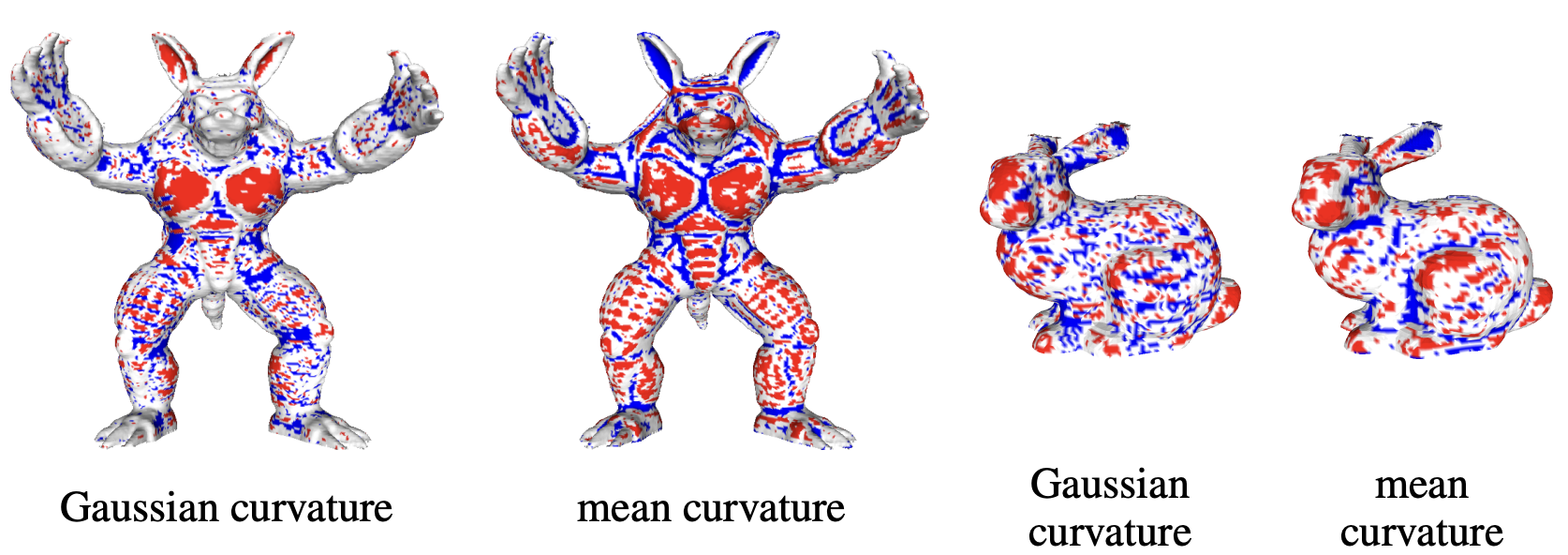Neural Surface Reconstruction
Enhancing Surface Neural Implicits with Curvature-Guided Sampling and Uncertainty-Augmented Representations

Abstract
Neural implicits have become popular for representing surfaces because they offer an adaptive resolution and support arbitrary topologies. While previous works rely on ground truth point clouds, they often ignore the effect of input quality and sampling methods during reconstructing. In this paper, we introduce a sampling method with an uncertainty-augmented surface implicit representation that employs a sampling technique that considers the geometric characteristics of inputs. To this end, we introduce a strategy that efficiently computes differentiable geometric features, namely, mean curvatures, to augment the sampling phase during the training period. The uncertainty augmentation offers insights into the occupancy and reliability of the output signed distance value, thereby expanding representation capabilities into open surfaces. Finally, we demonstrate that our method leads to state-of-the-art reconstructions on both synthetic and real-world data.
Overview

Curvature Estimation from Depth

Depth images can provide more geometric information other than normals. To solve the biased sampling problem, we propose directly incorporating mean curvature during the voxelization step to help with the sampling procedure during training. To our knowledge, we are the first to integrate mean curvatures, computed from depth images, with voxels for efficient sampling afterward. A depth image can be viewed as a Monge patch of a surface, i.e. $z = D(m,n), (m,n) \in \Omega \subset \mathbb{R}^2$ with pixel coordinates $(m,n)$ lay in the image domain $\Omega$. Thus, the Monge patch $\boldsymbol{M}: \Omega \to \mathbb{R}^3$ is $\boldsymbol{M}(m,n) = (m, n, D(m,n))$. To compute the two types of curvatures from the depth
\[K(m,n) = \frac{D_{mm}D_{nn} - D_{mn}^2}{(1+D_m+D_n)^2}\] \[H(m,n) = \frac{(1+D_m^2)D_{nn} - 2D_m D_n D_{mn} + (1+D_n^2)D_{mm}}{2 (1+D_m^2 + D_n^2)^{3/2}}\]Curvature Guided Sampling

Curvature guided sampling. To sample points using curvature information. Left images is the high curvature gathering effect when directly sampling using voxels, right side is sample using our methods.
To avoid the uneven sampling problem, we divide sampled points into low, median, and high curvature regions. For each epoch, m points are sampled from low curvature category $\hat{\mathbf{p}} \sim {\mathbf{p} \in \Gamma | H^p < \underline{H}}$, median curvature category $\hat{\mathbf{p}} \sim {\mathbf{p}\in\Gamma | \underline{H} \leq H^p < \bar{H}}$, and high curvature category $\hat{\mathbf{p}} \sim {\mathbf{p} \in\Gamma | H^p \geq \bar{H}}$.
Voxel-based Sampling

voxel interpolation sampling. Allows us to get SDF value of any point in the space. To efficiently dealing with sparse input data.
we introduce an interpolation strategy that deals with the sparse input and uses the gradient and curvature information. With the initialized coarse voxel representation ${\mathbf{v}_i}$, we first sample a random point $\mathbf{p} \in \Gamma$ in 3D space, where $\Gamma \subset \mathbb{R}^3$ is the sampling domain. With the help of the voxel grid structure, we can localize in which voxel the point $\mathbf{p} \in \mathbb{R}^3$ lies and denote the coordinate of the voxel center as $\mathbf{v}(\mathbf{p}) \in \mathbb{R}^3$. Then, the signed distance value of the sampled point $\mathbf{p}$ can be easily computed by Taylor expansion with the help of the stored gradient $\mathbf{g}^v$ as
\[\psi^p = \psi^v + <\hat{\mathbf{g}}^v, \mathbf{p} - \mathbf{v}(\mathbf{p})> \,,\]where $\hat{\mathbf{g}}^v = \frac{\mathbf{g}^v}{\lVert\mathbf{g}^v\rVert}$ is the normalized gradient of the distance field.
Open-surface Reconstruction Via SDF
Our method can handle open surface easily.

We would like to recover the neural implicit function $f:\mathbb{R}^3 \to (\psi, w) \subset \mathbb{R}\times[0,1]$, such that the surface lies on the level-set ${\mathbf{x} | f(\mathbf{x}) \in 0 \times (\tau,1] }$, and w is the uncertainty of the predicted signed distance value $\psi$. $\tau$ is the uncertainty threshold. Given a point $\mathbf{p}$ in the sample domain $\Gamma$, its corresponding voxel $\mathbf{v}(\mathbf{p})$ with the interpolated SDF value $\psi^p$ and uncertainty $w^p$, we define the loss function of the geometric and the normal constraints as
\[\mathit{l}_{\boldsymbol{X}}(\theta) = \frac{1}{\|\Gamma^+\|}\int_{\Gamma^+} (\|\psi - \psi^p\|)d\Gamma \,,\] \[\mathit{l}_{\boldsymbol{N}} (\theta) = \frac{1}{\|\Gamma^+\|} \int_{\Gamma^+} (1- <\frac{\nabla_{\psi} f(\mathbf{p}, \theta)}{\lVert\nabla_{\psi} f(\mathbf{p}, \theta)\rVert}, \hat{\mathbf{g}}>)d\Gamma \,,\] \[\mathit{l}_{\boldsymbol{W}}(\theta_r) = \int_{\Gamma} \|w - w^p\|d\Gamma \,,\] \[\mathit{l}_{\boldsymbol{E}}(\theta) = \int_{\Gamma} \|\lVert\nabla_\psi f(\mathbf{p},\theta)\rVert^2 - 1\| d\Gamma \,,\]where $\Gamma^+$ indicates the area with the sampled uncertainty $w^p>0$.
Results


Citation
@inproceedings{sang2023enhanching,
title = {Enhancing Surface Neural Implicits with Curvature-Guided Sampling and Uncertainty-Augmented Representations},
author = {L Sang and A Saroha and M Gao and D Cremers},
booktitle = {ECCV workshop: wild in 3D},
year = {2024},
titleurl = {sang2023.png},
}